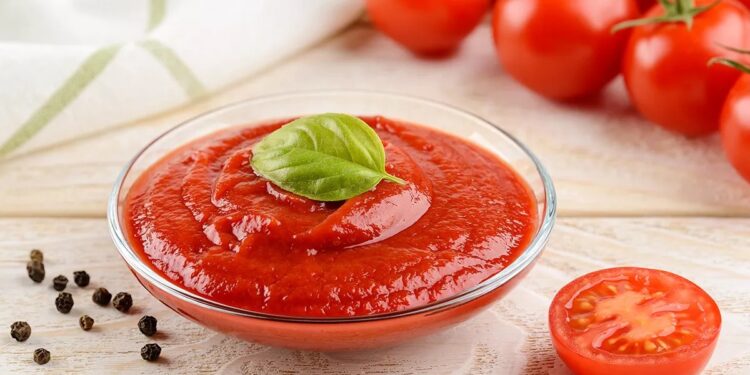While store-bought tomato passata is cheap and convenient, there is simply no comparison to making it yourself from your own garden-grown tomatoes. Here’s how to do it in the traditional Italian way.
Release your inner nonna by making the most of the late-summer harvest of ripe, plump tomatoes and make the perfect passata pomodoro that you can use throughout the year to take your Italian cooking to the next level.
The reason Italian food is so popular all over the world is because it is intrinsically simple. Most iconic Italian pasta dishes, for example, contain a maximum of four ingredients, including the pasta, so, as any Italian nonna will tell you, ingredient quality is utmost. That’s why it’s important to make your passata at the height of the harvest season when the tomatoes are sun-ripened and at their juiciest.
Of course, it’s always best to grow your own tomatoes, which is easy, but it’s perfectly acceptable to buy them from the farmers’ market or the store. You usually see the store filled with crates of tomatoes in August and at great prices too—that’s the time to act, don’t wait, buy more tomatoes than is reasonable to have in your kitchen. Once you get them home, you’ll have all the motivation you need to turn them into a passata that can act as the foundation for pasta or pizza sauces as well as soups and stews throughout the winter.
Any tomato can be turned into a passata, but if you are looking for the ultimate varieties the Italians use then go for Roma, San Marzano, Viva Italia, or Super Italia Paste.
Step 1: Select
The first and possibly most important step in making your passata pomodoro is to select the tomatoes. Many tomatoes will have dark spots on them and that’s fine, simply remove the dark parts on the skin with a sharp knife, and discard these in your compost heap. You are looking for tomatoes that are plump but firm. Remove any tomatoes that are soft or have soft parts.
Step 2: Prepare
Dump your tomatoes into a sink and wash them thoroughly with cold water. Remove all the stalks and leaves and cut them in half. The passata is made from the flesh and juice of the tomato, so remove the skins and the seeds, which will make the passata bitter and grainy. There are several ways to remove the unwanted parts of the tomato, traditionally a passata maker or passaverdure is used, a machine that grinds out the pulp and separates the seeds and skins, but for the purposes of this article, let’s assume you don’t own one of these.

Once you have cut the tomatoes in half, you can use a spoon to scoop out the seeds. Again, keep these, you can place them in a bowl with some water and leave them for a few days to ferment slightly. Strain them well and place on a dry dish towel, then roll them about with the towel to remove the gel-like covering. Place them on another dry towel and leave them in the sun or a sunny spot in your kitchen to dry. These can then be planted straight away or saved to plant next year.
Step 3: Blanch
Place what remains of your tomatoes into a large stainless-steel pot and bring to the boil. Allow to simmer for 2-3 minutes, then scoop them out and place them in a large bowl or bucket of cold water. You can add ice to this water to stop the cooking process and make the next stage a little easier, but it’s unnecessary.
Step 4: Remove the skins
Use a semi-blunt pairing knife to peel off the skins of the tomatoes. The skins can be added to the compost heap along with the rest.
Step 5: Cook
Transfer your tomatoes back to the pot and cover with water. Bring to the boil and cook for 10 minutes. Turn off the heat and allow the water and tomatoes to cool down completely.
Step 6: Blend
There are a few different ways to do this. You can use a blender or food processor, or even a Nutribullet. It depends on what kind of consistency you want from your passata. If you want it fully smooth, use a blender, however, if you prefer a more ‘rustic’ rough consistency, the best way is to use your hands. Simply roll up your sleeves and squish the tomatoes with your hands, the kids will love to help at this stage.

Stage 7: Store
Ideally, the passata should be vacuum sealed in jars. To do this, ladle the passata into jars; a wide-mouthed funnel is useful. Fill up to one inch from the top and place the lids on. Any jar will do, but the tall passata jars from your store-bought product will do fine. The reason they work well is that they occupy a small space when placed back into the pot, meaning you can pack them in when you are creating the vacuum. Place them standing up in a pot of water. Place a couple of kitchen cloths around the jars to prevent breakage. Then cover the jars with water and bring to the boil, lower the heat, and simmer for 30 minutes. This will create a vacuum and prevent the growth of bacteria that could spoil your passata.
If this sounds like too much trouble, you can always freeze your passata pomodoro where it will keep well for a long time.
Source: Fine Dining Lovers



Recent Comments